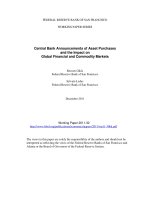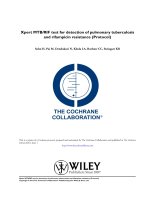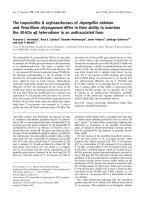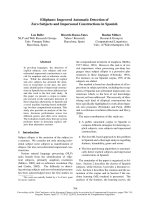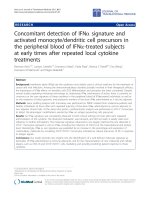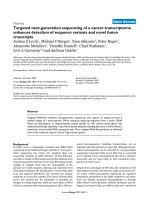Detection of toxigenic isolates of aspergillus flavus and related species on coconut cream agar
Bạn đang xem bản rút gọn của tài liệu. Xem và tải ngay bản đầy đủ của tài liệu tại đây (340.24 KB, 4 trang )
Journal of Amlied Bacteriology 1994, 76, 75-78
Detection of toxigenic isolates of Aspergillus f l a w s and
related species on coconut cream agar
Sonya K. Dyer and Sharee McCammon
CSIRO Division of Food Science and Technology,North Ryde, NSW, Australia
4573/05/93: accepted 30 July 1993
AN D s. M cc A M M o N . 1994. A new readily-prepared medium, coconut cream agar, was
developed for the detection of aflatoxin production by isolates of Asp_ergillusJavus a n d related
species. Coconut cream agar, which comprised coconut cream (50%) and agar (1.5%),
detected isolates of A. jlavus more effectively than the synthetic media tested a n d was as
effective as media containing desiccated coconut. Fluorescence colouring of colonies grown on
coconut cream agar could be used to differentiate A. flavus from A . parasiticus a n d A . nomius.
In addition, conidial colour of A.Javus a n d A . nomius was quite distinct from that of A .
parasiticus.
s. K . D Y E R
INTRODUCTION
Detection of Aspergillus flavus Link and A. parasiticus
Speare is readily accomplished by plating on Aspergillus
flavus and parasiticus agar (AFPA) (Pitt et al. 1983). T h e
two species can then be distinguished microscopically
(Klich and Pitt 1988). However, only 40% of A . flavus isolates produce aflatoxins (Klich and Pitt 1988), so a medium
capable of detecting aflatoxin production while also differentiating between A . flavus and A . parasiticus would have
considerable value.
Media which permit detection of aflatoxins by fluorescence under long wave ultraviolet (u.v.) radiation have been
the subject of research since the 1960s. Early work with
natural media used peanuts or coconut in a Czapek-Dox
medium with Hyflo-Supercel added to produce a white
background (de Iongh et al. 1964; de Vogel et al. 1965;
Arseculeratne et al. 1969). Preparation of these media in
large volumes is time-consuming.
Aflatoxin Producing Ability medium (APA) (Hara et al.
1974), a modified Czapek agar, contained corn steep liquor
which is not universally available. Wicklow et al. (1981)
found that APA did not give false positives, but
occasionally gave false negatives. More recent media contained coconut in the form of coconut meat, or desiccated
or shredded coconut (Lin and Dianse 1976; Davis et al.
1987).
Austwick and Ayerst (1963) produced a synthetic
medium that fluoresced in the presence of aflatoxin. T h e
synthetic liquid medium of Adye and Mateles (1964)
(A&M) has been widely used to assess aflatoxin production.
Correspondence t o : Miss S . K . Dyer, CSIRO Division of Food Science and
Technology, PO Box 52, North Ryde, NSW 2113, Australia.
Addition of agar enabled use of a scanning densitometer
with a fluorometry attachment to determine aflatoxin concentrations directly (Cotty 1988). El-Naghy et al. (1991)
reported better aflatoxin production in A&M medium than
on natural substrates. Naik et al. (1970), however, showed
increased aflatoxin production in A&M liquid by adding
peanuts or coconut. Venkitasubramanian (1977) also found
that A&M medium did not support high yields of aflatoxin
and so modified it by adding asparagine and increasing the
concentration and number of trace elements to form Synthetic Low Salts medium.
Yabe et al. (1987) grew A . flavus isolates on glucose (2%)
yeast (0.5%) extract agar then photographed the reverse
sides of colonies under U.V. light. This method has the
drawback of needing a u.v.-transparent camera lens.
Aspergillus nomius, a third species capable of producing
aflatoxins, was described by Kurtzman et al. (1987). Aspergillus nomius is morphologically similar to A . flavus but produces distinctive bullet-shaped sclerotia. Like A .
parasiticus, it produces G aflatoxins. Its behaviour on media
for detecting aflatoxin production has not been assessed.
This paper reports a modification of coconut extract agar
which is easily prepared, effective for detecting aflatoxin
production, useful for distinguishing A . flavus from A .
parasiticus and may aid in the detection of A . nomius.
M A T E R I A L S AND METHODS
Fungi
Six toxigenic fungal isolates were studied: A. flavus FRR
2746, FRR 2754 and FRR 2882; A . parasiticus FRR 2744,
FRR 2752 and FRR 3385; and a nontoxigenic A. flavus,
76 SONYA K. DYER A N D S H A R E E M c C A M M O N
FRR 2879. FRR denotes the culture collection of the
CSIRO Division of Food Science and Technology, North
Ryde, NSW, Australia. Production of toxins was determined by thin layer chromatography (TLC) (Filtenborg et
al. 1983).
Six A. nomzus isolates, FRR 3543, FRR 3544, FRR 3545,
FRR 3546, FRR 3547 and FRR 3673, were examined on
coconut cream agar to determine if they could be differentiated from A. JEavus.
Spores of all isolates were inoculated at three points on
three plates of each medium, then incubated at 30°C in
darkness.
Media
Media reported to support aflatoxin production (Table 1)
were compared for their ability to detect aflatoxin under
long wave U.V. radiation. With the exception of coconutbased media and A&M medium, these formulations have
not been examined previously for in situ fluorescence.
Several other experimental media were prepared during the
course of this work and also studied. These were 100%
coconut milk (Leecan, Penang, Malaysia), 40, 50 and 60%
coconut milk powder (NestlC, Sri Lanka) and 30, 40, 50
and 60% coconut cream (Trident, Thailand). Agar (1.5%)
was added to all media, which were dispensed at approximately 20 ml per Petri dish. Fluorescence under long wave
U.V. light (two XX15c 15 watt globes: Ultra Violet Products, San Gabriel, USA) was observed from 3 to 7 d after
inoculation.
Coconut cream agar vs Adye and Mateies agar
A comparative study was made of fluorescence on the most
effective of the synthetic and natural media. These were
50% coconut cream agar (CCA) and A&M agar. Media
were made, inoculated and observed as outlined above.
Fifteen isolates each of A. fIavus and A. parasiticus from
the FRR culture collection were studied. Spore colour was
also noted after incubation for 7 d.
Comparison with chromatography
The effectiveness of CCA for aflatoxin detection was compared with T L C using 95 toxigenic isolates of A. JEavus.
These had been isolated from peanut plants and soils from
Australia and grains from Thailand or were from the FRR
culture collection. Cultures were inoculated on CCA, incubated at 30°C for 4 d then examined under U.V. light. For
T L C cultures were grown on Czapek Yeast Extract agar
(Pitt 1973) for 7 d. Isolates which did not produce detectable toxins on Czapek Yeast Extract agar were grown on
CCA for 7 d and retested by TLC.
RESULTS
Comparison of media
Comparison of coconut cream media containing 40-60%
coconut cream (Table 2) indicated that 50% was optimal:
this concentration was used to produce coconut cream agar
(CCA). CCA (50% coconut cream) was found to be as
effective for detecting A. Jlavus and A. parasiticus as media
made with dried coconut, and has the advantage of being
rapidly and readily prepared. Trials with six brands of
coconut cream showed they could all be used to detect fluorescence. In these experiments Trident coconut cream was
found to give the strongest fluorescence.
Table 1 Media tested for fluorescence in the presence of aflatoxin
Medium
Composition
Reference
Shredded coconut
Desiccated coconut
Adye & Mateles
Filtrate from blended, shredded coconut
Filtrate from blended, desiccated coconut
Glucose, KH,PO,, (NH,),SO,, MgSO,
and six trace elements
Glucose, (NH,),SO,, K,HPO,, KH,PO,,
glycine, glutamic acid, MgSO, and
three trace elements
Sucrose, asparagine, KH,PO,, (NH,),SO,,
MgSO, and six trace elements
Sucrose, asparagine, (NH,),SO,
and eight trace elements
Sucrose, yeast extract, K,HPO,
and four trace elements
Sucrose, yeast extract
Sucrose, yeast extract, KNO, , MgSO,
Glucose, malt extract, peptone
Davis et al. 1987
Davis et al. 1987
Adye and Mateles 1964
Glucose salts
Synthetic
Synthetic low salts
Czapek
Yeast extract
Semisynthetic
Malt extract
Shih & Marth 1974
Venkitasubramanian 1977
Reddy et al. 1971
Pitt 1973; Ambrecht et al. 1963
Davis et al. 1966
Diener and Davis 1966
Wicklow and Hesseltine 1979
DETECTION OF TOXIGENIC A . FLAVUS 77
~~
Table 2 Maximum fluorescence observed by isolates of Aspergillus jlavus and A. parasiticus
~~~~
~
Aspergillus fIavus
Medium
Shredded coconut
Desiccated coconut
Coconut cream 30%
Coconut cream 40%
Coconut cream 50%
Coconut cream 60%
Coconut milk powder 40%
Coconut milk powder 50%
Coconut milk powder 60%
Coconut milk
Adye & Mateles
Glucose salts
Synthetic low salts
Synthetic
Aspergdlus parasiticus
FRR
2746
FRR
2754
FRR
2882
++
+++
++
++
++
+++
+++
+++
+++
++
+
+
+++
+++
+++
+++
+++
+++
+++
++
++
++
++
+
+
++
++
++
++
++
+++
+
++
++
++
+
-
FRR
2879
FRR
2744
FRR
3385
FRR
2752
++
++
++
+++
+++
+++
+++
+++
++
++
+++
+++
++
+++
+++
+++
+
++
++
++
++
++
++
++
+++
+++
++
+++
+++
-
+++
+
++
+++
+++
+++
++
++
+
+++
+++
++
+
+ + +, Very strong fluorescence; + +, strong fluorescence; +, detectable fluorescence; -, no fluorescence.
Coconut milk did not induce very strong fluorescence.
Coconut milk powder produced stronger fluorescence than
coconut milk and at the 40% concentration compared
favourably with desiccated and shredded coconut and
coconut cream agars. When grown on coconut milk powder
agar, A . parasiticus colonies produced copious exudate.
Exudate production was also observed on shredded and
desiccated coconut agars, but to a lesser extent.
Synthetic media were not as effective as CCA. Synthetic
Low Salts, Glucose Salts and A&M media detected aflatoxin production by all of the A. parasiticus isolates but only
two of the three toxigenic A. faavus isolates (Table 2). Fluorescence by A. parasiticus was more intense on A&M and
Glucose Salts agars than on Synthetic Low Salts agar.
Conidia of A. faavus and A. parasiticus on Glucose Salts
agar were yellow in contrast with those on the other media
tested. Fluorescence was only detected in Venkitasubramanian’s (1977) synthetic agar in the presence of A . parasiticus. Colonies grown on this agar were wrinkled and broke
the agar surface. No fluorescence was observed on Semi-
synthetic, Yeast Extract Sucrose, Czapek or Malt Extract
agar.
Coconut cream agar vs Adye and Mateles agar
I n tests that compared CCA and A&M, all of the toxigenic
A. parasiticus isolates examined fluoresced on both media
(Table 3). Toxigenic isolates of A. faavus were detected
more frequently on CCA than on A&M. After incubation
for 7 d, isolates of A. flavus and A. parasiticus were identified by conidial colour with greater accuracy on CCA than
on A&M.
It was found that after incubation on CCA for 4 d, 93%
of the A. flavus isolates and 80% of the A. parasiticus isolates examined were correctly identified by the colour of
their fluorescence. Aspergillus flavus fluoresced pastel blue
(20-21A4) in a ring around each colony while A . parasiticus
fluoresced bluish white (2&23A2)(Kornerup and Wanscher
1978) over all of each colony. T h e A. nomius isolates also
fluoresced bluish white and could not be differentiated by
Table 3 A comparison between Adye & Mateles agar and coconut cream agar using 15 isolates of AspergillusfIavus and A . parasiticus
Toxigenic isolates which fluoresced (%)
Adye & Mateles agar
Coconut cream agar (50%)
Correctly identified by spore colour (%)
Aspergillus J a w s
Aspergillus parasiticus
Time of peak
fluorescence
(d)
53
100
100
100
5
4
Aspergillus jlavus
Aspergillus parasiticus
88
100
53
93
78 SONYA K . D Y E R A N D S H A R E E McCAMMON
fluorescence from A. parasiticus. Very bright white fluorescence by a few cultures has been observed. I t is not clear
whether this is due to aflatoxin or a masking compound.
Comparison with chromatography
Detection of toxigenic isolates by CCA was found to correspond to TLC results for 86 of the 95 cultures of A. flavus.
T h e remaining nine cultures were positive on CCA but
negative on TLC plates.
DISCUSSION
Coconut cream is described by manufacturers as a concentrated cream extract from the fresh grated kernel of
matured coconut. T h e chemical basis of fluorescence on
CCA has not been investigated. Because of the high correlation between results on CCA and TLC plates and the
difference in colour of the fluorescence produced by A.
J a w s and A . parasiticus, it appears that the fluorescence is
due to aflatoxins. A s p e r g i l l u s f l a v u s and A. nomius are very
similar when examined both by eye and microscopically.
The difference in the colour of their fluorescence can be
used as a tool in the identification of A. nomius.
REFERENCES
Adye, J. and Mateles, R.I. (1964) Incorporation of labelled compounds into aflatoxins. Biochimica et Biophysica Acta 86, 418420.
Ambrecht, B.H., Hodges, F.A., Smith, H.R. and Nelson, A.A.
(1963) Mycotoxins. I. Studies on aflatoxin derived from contaminated peanut meal and certain strains of Aspergillus flavus.
Journal of the Association of Official Agricultural Chemists 46,
805-8 17.
Arseculeratne, S,N., De Silva, L.M., Wijesundera, S. and Bandunatha, C.H.S.R. (1969) Coconut as a medium for the experimental production of aflatoxin. Applied Microbiology 18, 88-94.
Austwick, P.K.C. and Ayerst, G. (1963) Groundnut microflora
and toxicity. Chemistry and Zndustry 2, 55-61.
Cotty, P.J. (1988) Simple fluorescence method for rapid estimation of aflatoxin levels in a solid culture medium. Applied and
Environmental Microbiology 54, 274-276.
Davis, N.D., Diener, U.L. and Eldridge, D.W. (1966) Production
of aflatoxins B, and G, in a semisynthetic medium. Applied
Microbiology 14, 378-380.
Davis, N.D., Iyer, S.K. and Diener, U.L. (1987) Improved
method of screening for aflatoxin with a coconut agar medium.
Applied and Environmental Microbiology 53, 1593-1595.
De Iongh, H., Vles, R.O. and De Vogel, P. (1964) The occurrence
and detection of aflatoxin in food. In Mycotoxins in Foodstufs
ed. Wogan, G.N. pp. 235-245. Cambridge: M I T Press.
De Vogel, P., Van Rhee, R. and Koelensmid, W.A.A.B. (1965) A
rapid screening test for aflatoxin-synthesizing aspergilli of the
flavus-oryzae group. Journal of Applied Bacteriology 28, 213220.
Diener, N.D. and Davis, U.L. (1966) Aflatoxin production by isolates of Aspergillusflavus. Phytopathology 56, 1390-1393.
El-Naghy, M.A., Mazen, M.B. and Fadl-Allah, E.M. (1991) Production of aflatoxin B, by Aspergillus flavus isolated from
stored cotton seeds with different substrates. World Journal of
Microbiology and Biotechnology 7, 67-71.
Filtenborg, O., Frisvad, J.C. and Svendsen, J.A. (1983) Simple
screening method for molds producing mycotoxins in pure cultures. Applied and Environmental Microbiology 45, 581-585.
Hara, S., Fennell, D.I. and Hesseltine, C.W. (1974) Atlatoxinproducing strains of Aspergillus flavus detected by fluorescence
of agar medium under ultraviolet light. Applied Microbiology 27,
1118-1 123.
Klich, M.A. and Pitt, J.I. (1988) Differentiation of Aspergillus
flavus from A . parasiticus and other closely related species.
Transactions of the British Mycological Society 91, 9%108.
Kornerup, A. and Wanscher, J.H. (1978) Methuen Handbook of
Colour. London : Eyre Methuen
Kurtzman, C.P., Horn, B.W. and Hesseltine, C.W. (1987) Aspergillus nomius, a new aflatoxin-producing species related to
Aspergillus flavus and Aspergillus tamarii. Antonie van Leeuwenhoek 53, 147-158.
Lin, M.T. and Dianse, J.C. (1976) A coconut-agar medium for
rapid detection of aflatoxin production by Aspergillus spp. Phytopathology 66, 1466-1469.
Naik, M., Modi, V.V. and Patel, N.C. (1970) Studies on aflatoxin
synthesis in Aspergillus flavus. Indian Journal of Experimental
Biology 8, 345-346.
Pitt, J.I. (1973) An appraisal of identification methods for Penicillium species : novel taxonomic criteria based on temperature and
water relations. Mycologia 65, 1135-1 157.
Pitt, J.I., Hocking, A.D. and Glenn, D.R. (1983) An improved
medium for the detection of Aspergillus flavus and A . parasiticus. Journal of General Microbiology 101, 35-40.
Reddy, T.V., Viswanathan, L. and Venkitasubramanian, T.A.
(1971) High aflatoxin production on a chemically defined
medium. Applied Microbiology 22, 393-396.
Shih, C.N. and Marth, E.H. (1974) Some cultural conditions that
control biosynthesis of lipid and aflatoxin by Aspergillus parasiticus. Applied Microbiology 27, 452456.
Venkitasubramanian, T.A. (1977) Biosynthesis of aflatoxin and its
control. In Mycotoxins in Human and Animal Health ed. Rodricks, J.V., Hesseltine, C.W. and Mehlman, M.A. pp. 83-98.
Park Forest South, IL: Pathotox Publishers.
Wicklow, D.T. and Hesseltine, C.W. (1979) Fluorescence produced by Aspergillusflavus in association with other fungi in autoclaved corn kernels. Phytopathology 69, 589-591.
Wicklow, D.T., Shotwell, O.L. and Adams, G.L. (1981) Use of
aflatoxin-producing ability medium to distinguish aflatoxinproducing strains of Aspergillus flavus. Applied and Environmental Microbiology 41, 697-699.
Yabe, K., Ando, Y., Ito, M. and Terakado, N. (1987) Simple
method for screening aflatoxin-producing molds by UV photography. Applied and Environmental Microbiology 53, 23G234.
